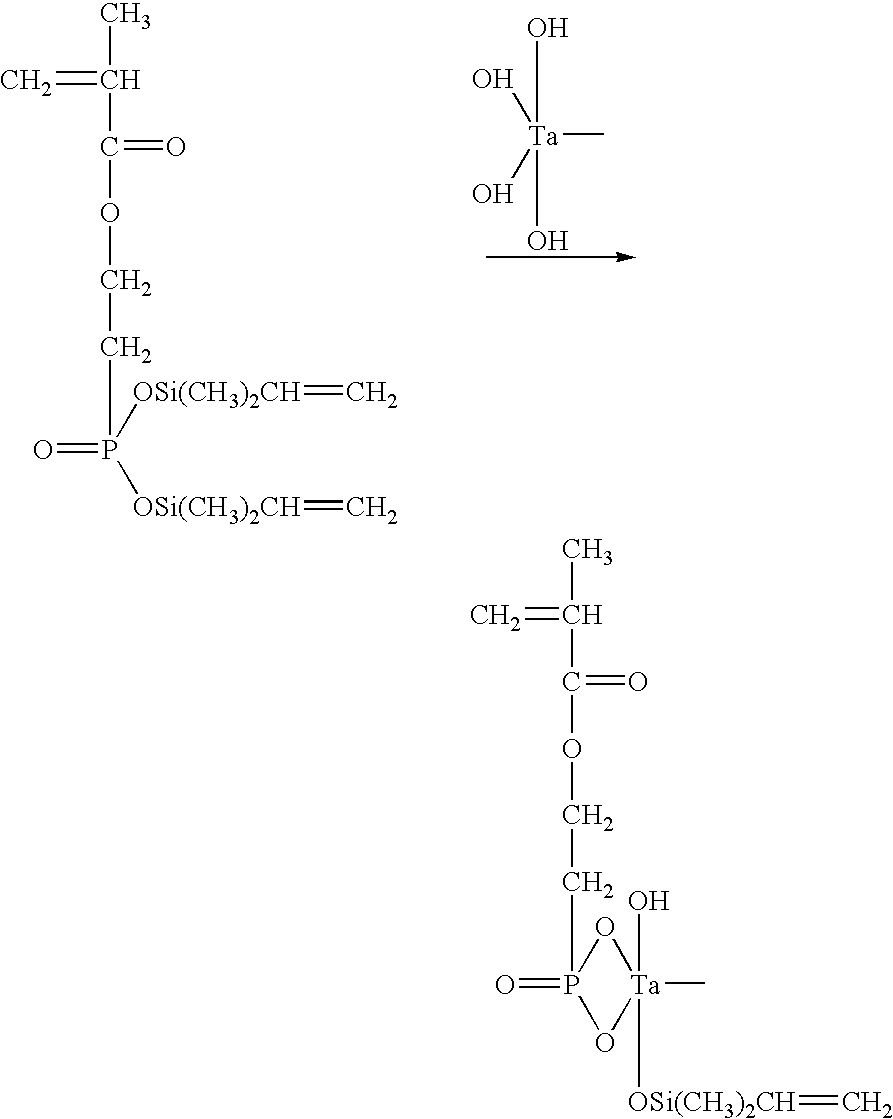Functionalized zirconium oxide particles
a zirconium oxide and functional technology, applied in the field of metal oxide particles, can solve the problems of not being radiopaque, unable to be homogeneously dispersed within the matrix, and reducing so as to achieve the effect of reducing the workability of composite materials, increasing viscosity, and reducing the viscosity
- Summary
- Abstract
- Description
- Claims
- Application Information
AI Technical Summary
Benefits of technology
Problems solved by technology
Method used
Image
Examples
example 1
ZrO2 Cluster Synthesis by Aqueous Hydrolysis
[0064]A solution of 10.8367 g of 70% (w / w) zirconium propoxide in propanol was added to a round-bottom flask under nitrogen gas reflux to yield 2.32×10−2 moles of the pure alkoxide. The solution was diluted by further adding 60 ml normal propanol while stirring with a magnetic stir bar. To completely hydrolyze the alkoxide, the amount of water added was twice the molar amount of zirconium propoxide, i.e. 4.63×10−2 mole. 0.84 ml water was diluted with 40 ml normal propanol, and this solution was added to the flask dropwise (by burette) while stirring vigorously. The solution gradually became cloudy as the water was added. In order to increase the rate of hydrolysis, the solution was slightly acidified by adding 0.16 ml concentrated nitric acid to the flask. The solution clarified somewhat, remaining slightly hazy. Stirring was continued for about 2 hours. 2.3 ml (−4.63×10−2 mol.) of pure neopentyl(diallyl) methacryl zirconate was diluted in...
example 2
ZrO2 Cluster Synthesis Enhanced by Formic Acid
[0067]10.3540 g of 70% (w / w) zirconium propoxide solution was added to a round-bottom flask under nitrogen gas reflux. The solution was diluted with 60 ml normal propanol while stirring with a magnetic stir bar. 0.4 ml water was diluted in 20 ml normal propanol, and this solution was added to the flask dropwise (by burette) while stirring vigorously. The solution became slightly cloudy after the water was added. Stirring was continued for approximately 12 hours, and 1.25 ml concentrated formic acid was added. The resulting solution was stirred for at least 30 minutes, and then 2 ml concentrated hydrochloric acid was added, reducing the system pH to nearly 1. Once the solution was clarified to the point of being only slightly hazy, 2.2 ml of pure neopentyl(diallyl) methacryl zirconate was diluted in 10 ml propanol and added to the flask dropwise (by pipette). Stirring was continued for at least 2 hours, and the solution was pump vacuum dr...
example 3
Composite Formation Using Zirconia Clusters
[0069]14.7783 g of a solution having a concentration of clusters of 10.15% (w / w) was added to a round-bottom flask, yielding 1.50 g clusters. Added to this solution, and mixed thoroughly, was 6.00 g of a blend of 37 wt % bis-GMA, 25 wt % tetra ethylene glycol dimethacrylate (TEGDMA), 37.5 wt % bis-EMA (an ethoxylated version of bis-GMA) with 0.2% camphorquinone and 0.3% 2-n-butoxyethyl-4-(dimethylamine)benzoate (CQ / amine) (photoinitiator for on-demand polymerization).
[0070]The flask was evacuated after mixing in order to remove the volatile methanol and silane from the system. The yield was 7.50 g of composite resin having a solids content of 20% (w / w). The mechanical properties (±1 standard deviation) of a variety of composite specimens prepared as indicated are given in the Table below:
[0071]The resin had a fluid consistency which was easily manually packed into transparent silicone molds in order to produce mechanical testing specimens f...
PUM
| Property | Measurement | Unit |
|---|---|---|
| diameter | aaaaa | aaaaa |
| cluster size | aaaaa | aaaaa |
| diameter | aaaaa | aaaaa |
Abstract
Description
Claims
Application Information
 Login to View More
Login to View More - R&D
- Intellectual Property
- Life Sciences
- Materials
- Tech Scout
- Unparalleled Data Quality
- Higher Quality Content
- 60% Fewer Hallucinations
Browse by: Latest US Patents, China's latest patents, Technical Efficacy Thesaurus, Application Domain, Technology Topic, Popular Technical Reports.
© 2025 PatSnap. All rights reserved.Legal|Privacy policy|Modern Slavery Act Transparency Statement|Sitemap|About US| Contact US: help@patsnap.com



